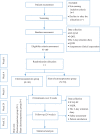Randomized controlled trial for the efficacy of electroacupuncture in the treatment of urge urinary incontinence: A clinical study protocol
- PMID: 32118759
- PMCID: PMC7478783
- DOI: 10.1097/MD.0000000000019315
Randomized controlled trial for the efficacy of electroacupuncture in the treatment of urge urinary incontinence: A clinical study protocol
Abstract
Background: Despite that the urge urinary incontinence (UUI) is a nonfatal disease, it can lead to anxiety, embarrassment and depression to the patient. UUI is a common public health problem that can significantly affect the quality of life of the patient. Several conservative treatments have been recommended for the treatment of UUI; however, their efficiency remains unclear, leaving the disease without a real effective treatment. The clinical application of acupuncture to treat UUI is currently considered an effective approach despite the limited evidence that support its efficiency. The aim of this study is to assess the efficacy and safety of electroacupuncture therapy in the treatment of UUI.
Methods and analysis: A randomized, parallel, controlled study will be performed. Patients with UUI treated with electroacupuncture group (EA) will compare with the sham-treated sham EA (SA) patients. A total of 100 participants with UUI will be randomly allocated to either the EA or the SA group with a 1:1 ratio. The treatment of UUI patients will performed 3 times per week, for 8 weeks in 30-minute sessions. At the end of the treatment the patients will be followed-up until week 32. The primary outcomes include scores of incontinence questionnaire-short form, the average 24-hour urgency incontinence episodes, and the average 24-hour urge episodes responses from baseline until the 4th, 8th , 24th, and 32nd week. The secondary outcomes included the average 24-hour urine volume and the average 24-hour micturition frequency responses from baseline until the 8th and 32nd week, as well as the change in incontinence quality of life scores from baseline at the 8th and 32nd week. In addition, the degree of satisfaction of the participants undergoing acupuncture treatment will be measured at the 4th and 8th week. The participants' clinical acupuncture expectations were evaluated at baseline, and the questionnaire for urinary incontinence diagnosis was used to identify stress incontinence, mixed urinary incontinence, and urge incontinence at baseline.
Discussion: This is a randomized, controlled, observer-blinded trial of electroacupuncture treatment for UUI. The results of this trial will provide more evidence on whether electroacupuncture is efficacious for treating UUI.
Conflict of interest statement
The authors have no conflicts of interest to disclose.
Figures
References
-
- Abrams P, Cardozo L, Fall M, et al. The standardisation of terminology of lower urinary tract function: report from the Standardisation Sub-committee of the International Continence Society. Neurourol Urodyn 2002;21:167–78. - PubMed
-
- Haylen BT, de D, Ridder, et al. An International Urogynecological Association (IUGA)/International Continence Society (ICS) joint report on the terminology for female pelvic floor dysfunction. Neurourol Urodyn 2010;29:4–20. - PubMed
-
- Lukacz ES, Santiago-Lastra Y, Albo ME, et al. Urinary incontinence in women: a review. JAMA 2017;318:1592–604. - PubMed
-
- Minassian VA, Sun H, Yan XS, et al. The interaction of stress and urgency urinary incontinence and its effect on quality of life. Int Urogynecol J 2015;26:269–76. - PubMed
-
- Milsom I, Coyne KS, Nicholson S, et al. Global prevalence and economic burden of urgency urinary incontinence: a systematic review. Eur Urol 2014;65:79–95. - PubMed
Publication types
MeSH terms
LinkOut - more resources
Full Text Sources
Medical



